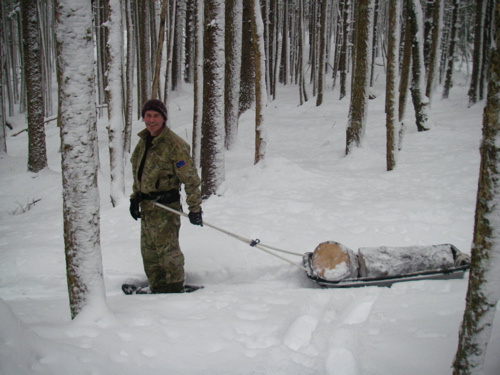In winter, we watch the snow pack on the trails for enough coverage to haul heavy loads with the pulk.
Our pulk is a Pelican sled that we’ve rigged with lines, poles, and carabiners to haul heavy loads over snow. With it, we can carry about three times as many wood rounds as I can haul on my back, with roughly the same amount of effort. When we hauled firewood in past years, Michelle and Aly took pack boards and carried a round each—light loads to allow them more agility so they could help hold back the sled’s weight on the downhill runs. All told, the three of us could bring 9 rounds of wood back to the cabin in one trip.

Three round haul, and still smiling. The pulk makes trucking heavy loada over snow much easier than packing (Photo: Michelle Zeiger).
I assembled the pulk several years back, based on information I found on line, primarily from The Pulk Book. I drilled holes along the gunwale of the sled, and threaded nylon line through it around the outside, then fed it through two lengths of PVC pipe. I secured each end with a carabiner. I crossed the poles and held them together with a bungee wrapped around the cross.
We found a pack waist belt on closeout at a local sporting goods store, and sewed webbing loops along each side. We fasten the carabiners to the most comfortable loops, then put on the belt, and we’ve got a hands-free harness for man hauling.
The big Pelican sled is expensive. A lot of people use shallower sleds, but I like the high sides of this model, that keep the load even when keeled over on its side. When we eventually have to replace it, we may go with a shallower sled, which will give us most of the hauling power at a reduced cost. It may also be easier to pull through the snow, which will no doubt help as we age.
Using the pulk is surprisingly easy. I hold the end of each pole as I go; the crossed poles allow steering by pulling the pole on the side I want the sled to turn. For particularly tight turns, a push on the opposite pole helps guide the nose of the sled.
It’s a fair workout, particularly when wearing snowshoes. The sled tends to fill with snow shaved off the edges of the path or falling from above. If that gets too bad, we have to stop to shovel it out.
On downhill sections, we often trail a line out the back for someone to hold onto and retard the forward momentum of the sled. In the really steep spots, I’ll turn the pulk around and buckle the harness on backwards so that I can lean back against the weight of the load.
A pulk may seem to have limited applications in our fossil-fuel guzzling society, but cross-country skiers and other wilderness trekkers use them often. For us, it’s the best way to move heavy loads in the winter.
